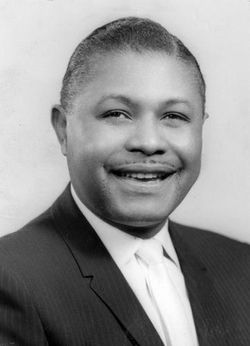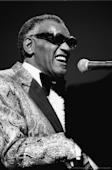Bobby “Blue” Bland (1930-2013): The downbeat of cultural exploitation.
By Malik Sekou Osei March 6, 2014
In the barren world of American culture and its aesthetics of white supremacy of racial denial and “form over content” of its art, where most of its expression could only developed into an art of empty entertainment. Where its dynamic has been more involved in imagery than social understanding of experience.
While, the American aesthetic has been an aesthetic of denial and the most common denominator of were mostly assured as entertaining and anything that wasn't socially challenging to the white American status quo. Nonetheless, what is normally forgotten in the US is that art and a standard of aesthetics is the first step of cognitive development about the social world, if the art is about telling the “truth.”
As the world become a bit more sterile, as of last year the world has had to face a deep and profound tragedy in the losing of brother Bobby “Blue” Bland, one of the more significant and extraordinary rhythm and blues (R&B) singers active back in the 50s and 1960s, died on last June 23 at the age of 83. While never quite the household name, but to a number of people who was more than familiar with this musical art form that his name stands out, outside of the more commercially successful contemporaries like Ray Charles or Aretha Franklin were, but has to be noted that brother Bland however was to make some remarkable contributions to popular music through his Blues approach.
Aretha Franklin
While the early expression of the Blues was under the commercial structure of racism and exploitation that would find expression in the content of the songs or lack of content outside of troubled romance. While, the lack of organization among Black musicians would give a dependency for covers of white artist who never respected the tradition, if the Black artist were to ever see a dime of royalties from the sales.
The lack of outright organization of Southern Black people was a normative of living within the white violence of supremacist of the “State Rights” of Jim Crow, and this would be reflected in their public music of the Blues.
The struggles of the art of the Blues and its expression that it path of expression was from the particular to remain in the particular and not discuss the larger social question of existence of southern life, meaning from the particular to the general.
Is has been shown that “Blues” Bland was more than a gifted, expressive and sensitive singer of profound emotional power, well-known for the guttural wails with which he often punctuated his phrasing. His singing also possessed very refined and sensitive qualities. He was more than an excellent and brilliant singer of ballads, in particular, earning himself the nick name “Sinatra of the Blues.”
In January 27, 1930 Robert Calvin Brooks was to come into the hostile world of American democracy of poverty in the American South to be later christen Bobby “Blue” Bland in the town of Rosemark in southwestern Tennessee, near Memphis. As a child, Bland missed out on a formal education as he left school to work in the cotton fields with his mother. He reportedly never attended school beyond the third grade, never learned to read and would remain mostly illiterate for most of his life. He knew all too well what he was singing about when he recorded the wonderful song “Poverty” years later in 1966, which was one of the few compositions that dealt with existence outside of the travails of forsaken romance.

Rev. C.L Franklin
Like so many R&B singers of his generation, Bland first developed his passion for music in the church. His singing style owes a particular debt to the rhetorical and oratorical flourishes heard in the taped sermons of the Reverend C.L. Franklin, a civil rights activist and the father of singer Aretha Franklin.
Memphis, Tennessee, where Bland would make his home, was also fertile ground for musical creativity in the 1950s as blues and early mimicking of quicken 3 beat to the bar of red-neck lumpen proletariat and emerged rock ‘n’ roll flourished in the mid-Southern city. Later Elvis Presley was to pimp the sound of the Black agricultural workers Elvis Presley as a young truck driver was to expose to this music and was to sing sang the songs of R&B singer Arthur “Big Boy” Crudup and from the local white corporate support of Elvis, where Elvis was to cover “Blue Suede Shoes,” “That’s All Right Mama,” “My Baby Left Me,” and a number of others where he was to become a major role in American popular music. What has to be noted was that Elvis was to only mimic the music and his popularity was based on his attitude of Black swagger. But he was never a created force in the music

Arthur "Big Boy" Crudup
B.B. King
Bland became part of a renowned combined of musicians known as the Beale Streeters, named after Memphis’s famed Beale Street, where they would often performed as a group. This collection of artists would include singer Johnny Ace, where once again Elvis was to cover Ace’s “Pledging My Love.” While the future blues icon B.B. King would be introduce to the world with whom Bland would strike up a lifelong friendship. Previous to his own successful career, Bland also once as worked King’s chauffer,
Elvis Presley
Bland struggled to land a hit record early on and his career would be interrupted in 1952 by the draft, when he was called up to serve in the US Army during the Korean War.
Bland finally hit his stride in the late 1950s and early 1960s, however, putting out a string of remarkable singles, including “Further on up the Road,” “Little Boy Blue,” “Cry, Cry, Cry,” “Stormy Monday Blues,” “I Pity the Fool,” and the great “Turn on Your Lovelight.” The album Two Steps from the Blues, released in 1961 and collecting just a few of these singles along with other recordings, proved to be an R&B landmark.
Contributing greatly to these recordings were the “big band”-inspired arrangements of trumpeter and composer Joe Scott with whom Bland would collaborate for many years.

John "Jabo" Starks

James Brown
Drummer John “Jabo” Starks, who went on to become a vital component of James Brown’s illustrious band, also accompanied Bland on several of these recordings. There are wonderful and exciting moments in “Turn on Your Lovelight” and “Don’t Cry No More” when all of the other musicians on the session drop out and leave Bland to sing with only Starks’ drums backing him up.
This was a music that was absolutely full of life. A great deal of real passion, pain, pleasure, hope and hardship courses through Bland’s best work.
Following the 1960s, Bland’s output was less and began to lack the power that his music once had. There were strong moments on albums such as His California Album (1973) and Dreamer (1974), but these did not match the strength of his earlier recordings.
A minor success at the time of its release, “Ain’t No Love in the Heart of the City,” from Dreamer, is now among Bland’s best-known recordings, thanks to its having been sampled in a 2001 song of the same title by rapper Jay-Z.
Two live albums recorded with B.B. King, Together for the First Time Live (1974) and Bobby Bland and B. B. King Together Again ... Live (1976), are also agreeable and entertaining.
Bland continued to perform until shortly before his death and recorded music as in recent times as 2003. In the end, his career spanned more than half a century. He was widely respected by his peers and his best music will no doubt continue to move audiences for a many years to come.
While, the evolution of the Blues within the US is a struggle of the aesthetic of truth telling of the conditions of the African American people, for all art is political for history is on their side, but not time and they needs an art that reflects such of social development and definition.

 Ray Charles
Ray Charles
No comments:
Post a Comment